Choosing the correct poker hands to three-bet bluff with can be very difficult. Many professionals of all levels fail to study enough and know the correct hands to bluff with in certain situations. Mistakes that are made in three-bet pots are magnified due to the size of the pot. Constructing a proper three-betting range is the first step in minimizing those mistakes.
Three-Betting Suited Versus Unsuited Cards
When I see someone three-betting offsuit combos such as K-J, my first assumption is that this player does not balance their three-betting range. There are 12 ways to make an offsuit hand preflop and only 4 ways to make a suited hand. If someone is not careful with their frequencies, their bluff ranges can quickly get out of whack because of how many three-bet offsuit combos they have. So, first rule of thumb is to stick to mostly suited combos when three-betting and avoid the offsuit combos in order to manage your frequencies.
Three-Bet With The Right Combinations
When choosing which combinations to bluff, you want to choose combinations that block the calling range of your opponent. For example, let’s say the cutoff opens and you are on the button. To know the best hands to three-bet, we should first look at the most common hands that the cutoff calls with. The most important card to have is an ace. From the cutoff, I would open every suited ace and offsuit aces down to A-5. At 100 big blinds, I would call the three-bet with all suited aces and fold my weakest offsuit aces. Therefore, when the button three-bets with an ace, it blocks the most hands that I would call with. The types of hands I would three-bet would be A-5 through A-9 suited. Like before, we want to three-bet more suited hands than offsuit.

Crush cash games and poker tournaments with Jonathan Little’s Top Ten Poker Tips!
Dominate The Dominated
You want to three-bet hands that get dominated hands to fold pre-flop. For example, A-5 suited is a great hand to three-bet pre-flop. When you three-bet A-5 suited, the cutoff is going to fold A-6 through A-9 offsuit. That is 48 combos of hands that dominated you and folded to your three-bet. Another example is a hand like K-7 suited, this folds out K-T offsuit, K-J offsuit and A-8 offsuit. When choosing hands to three-bet, choose hands that have high equity when called and can fold out dominated hands preflop.
The opposite holds true. You don’t want to three-bet hands that fold out the hands that dominate it, but still get called by hands that dominate it. For example, a hand like K-Q offsuit or K-J offsuit is often three-bet by people, the problem is it folds out hands it dominates, but hands like A-J and A-Q still call. While hands like A-J and A-Q still call the three-bet, hands such has K-T offsuit, K-8 suited, and K-5 suited fold, a disaster for K-Q. These hands isolate themselves against a stronger range. A hand such as K-8 suited fulfills more properties that we are looking for when three-betting, and is a better three-bet then a hand like K-Q offsuit in these positions.
Three-Bet Bluffing And Stack Sizes
When we are shallow stacked, we are more interested in three-betting hands that can make top pair and have strong blockers to the calling and shoving ranges of the opponent. Hands like A-7 offsuit and K-T offsuit fulfill these properties well. Hand playability doesn’t matter that much when the stack-to-pot ratio (SPR) is only two after three-betting short stacked. When deep stacked, hand playability matters much more and blockers are less important. Hands such as 8-7 suited and A-5 suited help fulfil these properties well.
Follow these tips next time you play to help construct better three-betting ranges. Have a reason for three-betting every hand in your range. Questioning why you are making a decision in poker is a great way to improve your ranges and decision making. Best of luck at the tables.




